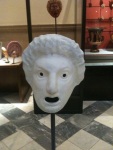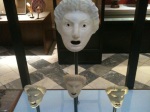Masks
Masks and ritual
The Greek term for mask is persona and was a significant element in the worship of Dionysus at Athens, likely used in ceremonial rites and celebrations. Most of the evidence comes from only a few vase paintings of the 5th century BC, such as one showing a mask of the god suspended from a tree with decorated robe hanging below it and dancing and the Pronomos vas, which depicts actors preparing for a Satyr play. No physical evidence remains available to us, as the masks were made of organic materials and not considered permanent objects, ultimately being dedicated to the altar of Dionysus after performances. Nevertheless, the mask is known to have been used since the time of Aeschylus and considered to be one of the iconic conventions of classical Greek theatre.
Mask details
Illustrations of theatrical masks from 5th century display helmet-like mask, covering the entire face and head, with holes for the eyes and a small aperture for the mouth, as well as an integrated wig. It is interesting to note that these paintings never show actual masks on the actors in performance; they are most often shown being handled by the actors before or after a performance, that liminal space between the audience and the stage, between myth and reality. ] This demonstrates the way in which the mask was to ‘melt’ into the face and allow the actor to vanish into the role. Effectively, the mask transformed the actor as much as memorization of the text. Therefore, performance in ancient Greece did not distinguish the masked actor from the theatrical character.
The mask-makers were called skeuopoios or “maker of the properties,” thus suggesting that their role encompassed multiple duties and tasks. The masks were most likely made out of light weight, organic materials like stiffened linen, leather, wood, or cork, with the wig consisting of human or animal hair. Due to the visual restrictions imposed by these masks, it was imperative that the actors hear in order to orientate and balance themselves. Thus, it is believed that the ears were covered by substantial amounts of hair and not the helmet-mask itself. The mouth opening was relatively small, preventing the mouth to be seen during performances. Vervain and Wiles posit that this small size discourages the idea that the mask functioned as a megaphone, as originally presented in the 1960s. Greek mask-maker, Thanos Vovolis, suggests that the mask serves as a resonator for the head, thus enhancing vocal acoustics and altering its quality. This leads to increased energy and presence, allowing for the more complete metamorphosis of the actor into his character.
Mask functions
In a large open-air theatre, like the Theatre of Dionysus in Athens, the classical masks were able to bring the characters’ face closer to the audience, especially since they had intensely over-exaggerated facial features and expressions.
They enabled an actor to appear and reappear in several different roles, thus preventing the audience from identifying the actor to one specific character. Their variations help the audience to distinguish sex, age, and social status, in addition to revealing a change in a particular character’s appearance, ie. Oedipus after blinding himself. Unique masks were also created for specific characters and events in a play, such as The Furies in Aeschylus’ Eumenides and Pentheus and Cadmus in Euripides’ The Bacchae. Worn by the chorus, the masks created a sense of unity and uniformity, while representing a multi-voiced persona or single organism and simultaneously encouraged interdependency and a heightened sensitivity between each individual of the group.
COSTUME DETAILS.
Actors who played tragic roles wore boots called cothurneses that elevated them above other actors.
When playing female roles, the male actors donned a ‘ prosterneda’ which is a wooden structure infront of the chest to imitate breasts.
There are little information on theatrical costumes. This is due to the perishable materials they have been made of. Still we have some information drawn from depictions on ancient pottery (see some pictures below).
Costumes have been a very important factor of the production, because they could determine the characters by gender or social status. In the early productions actors have been using body painting. Little by little they started using animal skins, ears, even feathers (see Aristophanes’ Birds).
When the poets introduced real costumes, they imitated the contemporary dressing : the “chiton” and the “hemateon”. The chiton was made of linen or silk and it was worn long. The hemateon was an exterior cloth, worn over the shoulders. It was usually made of wool. Both chiton and hemateon were decorated depending on the occasion. For theatrical use the clothes have been more decorated than usually.
In order to play female roles, since the actors were always men, they were wearing a “prosterneda” (in front of the chest, to imitate female breasts) and “progastreda” in front of the belly.
The actors used to put on ordinary shoes, such us loose fitting boots and laced boots. Is some scholars’ opinion, the actors used shoes with high heels (“kothornoi”). We cannot be sure about that, because we do not have a clear evidence from the pottery. In the later years (2nd century BC), it is sure that these shoes with high heels (“kothornoi”) have been introduced.
Use of costume in Athenian tragedy.
Some authors have argued that use of costume in Athenian tragedy was standardized for the genre.[1] This is said to have consisted of a full-length or short tunic, a cloak and soft leather boots, and may have been derived from the robes of Dionysian priests or invented by Aeschylus. Brockett, however, disputes this, arguing that the evidence we have is based on archaeological remains, some few references in the texts, and the writings of later authors. As far as the vase paintings are concerned, most of these are dated later than the 5th Century BCE and their relationship with theatrical practice is unclear. One of the earliest examples is a red-figure vase painting c. 500-490 BCE that shows a tragic chorus invoking a ghost, on a crater (bowl) in the Antikenmuseum in Basle.[2]
The tragic actors were certainly heavily disguised. This had a religious purpose, for the actor was supposed to give up his identity in order to let another speak and act through him. Indeed, the dramas were performed in honour of Dionysus, the God of Ecstasy, which means “standing outside oneself”[2]. Actors therefore had to renounce their individuality. The actors thought that the mask itself contained the character and are said to have prayed before putting on their masks. The costume was probably an elaborately-decorated version of everyday clothing worn in the 5th Century BCE. The garments included:
· chiton (robe or tunic)
· chlaina (overgarment)
· chlamys (short cloak)
· kothurnus (short lace-up boots)
· himation (overgarment)
· peplos (cloak)[3].
The chiton worn by the actors differed from that worn in everyday life because it incorporated sleeves, which were coloured and patterned. The sleeves may in fact have been part of an undergarment. Long white sleeves were worn by the (male) actors for female roles, and indeed, in vase paintings females are usually painted with lighter skin.
The costumes worn for the performances of Alcestis, for example, were iconographic, and symbolised the opposition of light and dark.[4] In the play, life is evoked as the act of seeing the sun. Death – the son of Night in Greek mythology – wears a black peplos and terrifying black wings. Apollo wears white, representing the sun. Admetus contrasts the black of the funeral procession with the white of the funeral procession. The corpse of Alcestis is dressed as a bride, in accordance with Greek tradition and Herakles wears a bearskin and carries a club.
The costumes worn gave the audience an immediate sense of character-type, gender, age, social status and class.[5]
Around the time of Aeschylus, the boots or buskins worn by the actors were flat. The actors had the same “status” as the chorus. In the 3rd Century BCE, the actors were raised to the status of heroes and “platform” soles began to be used, together with a head-dress called an onkos. The raised soles may have induced a stylised way of walking, suited to the rhythm of tragic verse, and the onkos made the actors taller, enhancing visibility. Their bodies were padded so that they did not look too slim.[6] However, some authors believe that this happened later than the 3rd Century BCE. It is also thought that the “teetering gait” is a misapprehension.[7]
The masks were the most striking feature of the costume worn by the Athenian actors. Facial expression was lost anyway due to the huge size of the Greek theatres, but the masks were also a means of blotting out expression, so visual meaning was expressed by the entire body. The actors were seen as silhouettes, or integral bodies, rather than faces. The masks themselves were made of stiffened linen, thin clay, cork or wood, and covered the whole head and had hair.
Attempts have been made in modern times to investigate the use of masks in Athenian tragedy through practice research.[8] These explorations conclude that masks may lead to a more demonstrative style of acting, with declamatory delivery of the lines substituted for intimacy. They also found that the mask could impede the projection of sound. The Greeks are said to have overcome this in various ways. Initially, the mouth apertures were small, but later this became a “wide-open” mouth. Some authors believe that the mouth was shaped like a “mouth-trumpet” and had an amplifying effect.[9] Certainly, the use of a mask covering the whole produces an enhanced resonating effect, which serves dramatic delivery.
Performances therefore had to be more physical. Peter Arnott states that the Greeks thought good acting and a good voice were synonymous. This was achieved through athletic training, voice exercises and diet.
Experiments have shown that unaccustomed actors suffer disorientation and restriction when masked. The Greeks countered this through a vocabulary of gesture known as cheironomia (gesticulation). Aristotle says that in his day excessive gestures were used – leading to overacting – compared with the older tradition.
Masks can also be used as a dramatic tool, e.g. lowering the masks shows reflection, raising the mask shows a challenge or superiority. The Greeks called these physical stances schemata (forms).
Silent masks were used to great effect, particularly on child actors, expressing powerlessness, bewilderment, vulnerability, etc.
The used of masks enabled the three speaking actors to portray up to eight or nine characters, through multiple role-playing. The same character could therefore be played by different actors, and transitions within a character would be portrayed by the use of different masks.
The wide variety of masks used is attested by Pollux, a rhetorician writing in 2nd Century CE, in hisOnomastikon.[10] He lists 30 different male masks (old age with white or grey hair, the tyrant with thick black hair, a fair, pale masks indicating sorrow or sickness, a boastful soldier, a rustic, servants, a cook, etc.) and 17 female masks (fat and thin old women, two matrons, one virgin, a bawd, a mistress, three courtesans, a lady’s maid, etc.).


